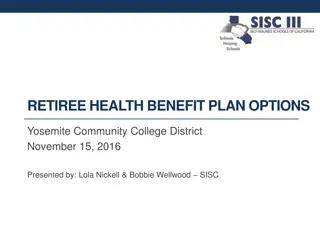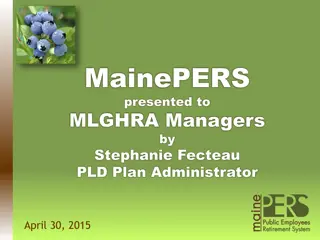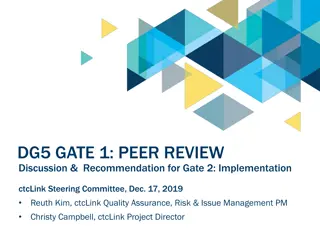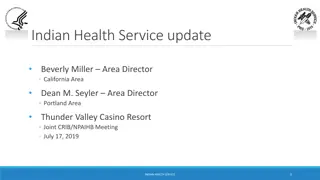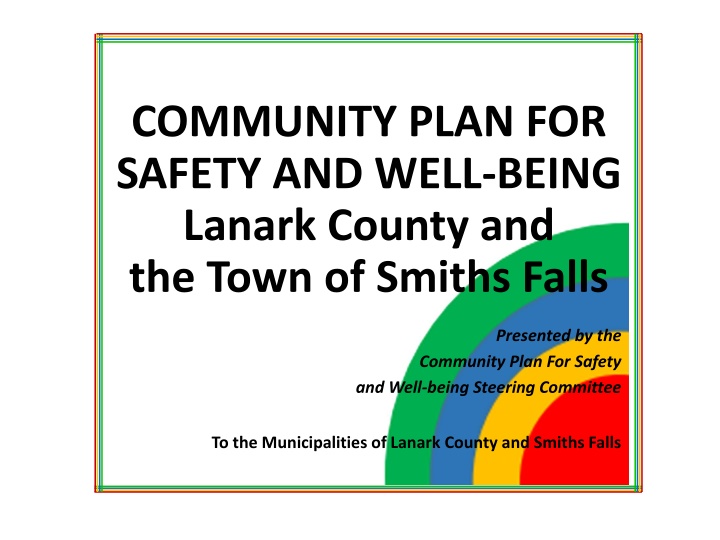
Community Plan for Safety and Well-being in Lanark County and Smiths Falls
"Learn about the collaborative efforts in Lanark County and Smiths Falls to identify and address systemic issues, improve community safety, and support vulnerable populations. Explore data, legislative requirements, and the development of a community plan for enhanced well-being."
Download Presentation

Please find below an Image/Link to download the presentation.
The content on the website is provided AS IS for your information and personal use only. It may not be sold, licensed, or shared on other websites without obtaining consent from the author. If you encounter any issues during the download, it is possible that the publisher has removed the file from their server.
You are allowed to download the files provided on this website for personal or commercial use, subject to the condition that they are used lawfully. All files are the property of their respective owners.
The content on the website is provided AS IS for your information and personal use only. It may not be sold, licensed, or shared on other websites without obtaining consent from the author.
E N D
Presentation Transcript
COMMUNITY PLAN FOR SAFETY AND WELL-BEING Lanark County and the Town of Smiths Falls Presented by the Community Plan For Safety and Well-being Steering Committee To the Municipalities of Lanark County and Smiths Falls
Background Lanark County Situation Table Project purpose: Bring multiple human-service sectors together to collectively identify systemic issues and risk factors prevalent locally and provide a network of support for vulnerable populations in our community in order to prevent crisis situations. Two main components: 1. Situation Table with agencies collaborating to identify and intervene in situations of acutely elevated risk 2. Development of a community plan for safety and well-being that identifies local prevalent risks and strategies to mitigate them
Situation Table Stats (Dec. 2015-Dec. 2018) 196 discussions: 79% met AER; 85% of those had overall risk lowered Top referrers continue to be police (60%) Mental health, criminal involvement and drugs are top three risk categories by discussion 24% of individuals at risk are in the 12- to 17-year age group; 48% from birth to 24 OPP data showing large drop in CFS for individuals after being referred by OPP to situation table (83%); also fewer officer hours devoted to individuals
Community Plan for Safety and Well-being: Provincial Legislation Legislative amendments to current Police Services Act mandate municipalities to prepare and adopt a plan; can be a joint plan with surrounding municipalities. Act came into force January 1, 2019 Under Act, Community Plans for Safety and Well- being to be adopted 2 years from Jan. 1, 2019 (by all local municipalities participating in joint plan) Act outlines requirements for advisory committee, consultation, establishing priority risks
Community Plan for Safety and Well-being: Additional Legislative Requirements Establish a multi-sectoral advisory committee including representatives from, but not limited to: Health/mental health services Educational services Community/social services Community & custodial services to children or youth* Children/youth services sector Municipal council member or municipal employee First Nations community PSB and Police Conduct consultations
Community Plan for Safety and Well-being: Additional Legislative Requirements Contents of the plan: Identifying priority risks (e.g. systemic discrimination and other social factors that contribute to crime, victimization, addiction, drug overdose and suicide) Identifying strategies to reduce the prioritized risk factors (e.g. new services, changing/coordinating existing services) Setting measurable outcomes Monitoring, evaluating, reporting requirements may be outlined in regulations at a later date. Publishing regulation: Internet within 30 days of adoption with a printed copy available for viewing
CSWB Plan for Lanark County & Smiths Falls Community-driven, regional plan undertaken prior to legislation Steering/Advisory Committee established with charter and terms of reference (late 2016) Plan outline and consultations (2016/17) Not reinventing wheel: identifies community assets and builds on existing work Identifies issues/gaps; includes strategies, measurable outcomes and potential working group team members when plan implemented Steering Committee approved July 4, 2018 Lanark County Council approved in principle Aug. 29, 2018; must be adopted by each municipality
Community Plan for Safety and Well-being Key components include: 12 priority risk areas and overview for each, including existing assets Specific identified issues and background for each Actions for each priority risk in areas of Social Development, Prevention, Risk Intervention and Emergency Response (work plan/implementation teams) Outcomes and measurables for each priority risk area Living document that will evolve with progress reports; revisit in three years
Priority Risk Areas 1. 2. 3. 4. 5. 6. 7. 8. 9. 10. Justice 11. Indigenous Health and Well-being 12. Culture and Diversity Mental Health Substance Use Poverty Housing Transportation Health and Well-being Domestic Violence/Sexual Assault Youth and Families Seniors Overlap between sections in several areas.
Youth and Families Identified Issues Increased supports for youth through schools, including drug treatment/mental health counsellors in high schools Work with youth and local post-secondary to establish training that takes less time for jobs in high demand; particularly for those who want to stay in communities with supports Sustainable funding for youth centres Mitigating issues for families with custody issues/parental alienation Inconsistency in delivery of Family and Children s Services programs due to large service area Awareness of literacy programs Supports for at-risk, low-income families; cutbacks for parenting programs Establish a social planning council Assist vulnerable youth with employment readiness
Youth and Families Outcomes Increased resources and access to (and/or promotion and education of existing ones) for children s hospital outpatient and addiction services, mental health supports related to gender identity for youth, supports/respite for families with high-needs children (including developmental disabilities), programs for pregnant teens, programs for life skills/employment readiness and needs; supports for victims of bullying and other violence/ exploitation, awareness and availability of emergency safe housing. Increased collaboration and planning related to youth and families to improve funding opportunities, collective impact and earlier crisis intervention.
Youth and Families Outcomes Increased child advocacy through child protection initiatives related to system training for agencies, support for kin families, court-related prevention measures around custody, development of child advocacy centre. All community schools kept open or repurposed as community hubs. Earlier identification of parenting support needs through existing or expanded programs, along with enhanced promotion of existing programs. Increased sustainability, efficiencies and shared programming for youth centres.
Other Relevant Identified Issues Mental Health: Children s mental health (LHIN boundaries, tertiary facility support, after-hours gaps, custody issues/parental alienation, respite services for children and/or parents) Substance Use: Specialized addictions services for youth (outcomes include reference to Planet Youth; services through schools) Poverty: Food insecurity, wage gaps, increased opportunities to help people move out of poverty Housing: Youth homelessness, affordable/supportive housing, emergencies Transportation: Affordable options Health & Well-being: Oral health, chronic care supports
Other Relevant Identified Issues Domestic Violence: Address high rates in rural areas (healthy relationships, intergenerational cycles) Justice: Youth released from custody with no housing supports, gangs/human trafficking, child advocacy centre Indigenous Health & Well-being: Lack of knowledge of shared history, lack of Indigenous services, addressing Calls to Action Culture and Diversity: Addressing stigma, discrimination, racism and bullying; centre for gender and sexual diversity, supports for new Canadians
Next Steps Completing municipal approvals Advisory Committee to meet overview of progress to date; coordinate implementation activities (tie-ins to Collaborative) Always tracking new issues Community Plan for Safety and Well-being for Lanark County and Smiths Falls: https://www.smithsfalls.ca/media/2019/01/CSWB-Plan- Presentation-for-Councils-final3.pdf
Questions? Stephanie Gray Lanark County Situation Table Coordinator/ Community Safety and Well-being Plan Coordinator LanarkCST@gmail.com 613-812-3778











